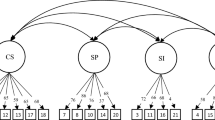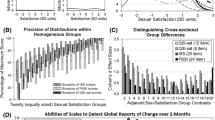Abstract
The purpose of the present investigation was to develop and validate an objective self-report instrument, the Multidimensional Sexuality Questionnaire (MSQ), designed to measure psychological tendencies associated with sexual relationships. Results indicated that the MSQ subscales had high internal consistency, test-retest reliability, and were largely independent of social desirability tendencies. Other results indicated that women and men responded in unique ways to the MSQ, with women reporting greater sexual-fear and men reporting greater sexual-esteem, sexual-preoccupation, sexual-motivation, sexual-assertiveness, and external-sexual-control. Additional evidence for the concurrent, discriminant, and convergent validity of the MSQ was found: the MSQ was associated not only with women's and men's sexual attitudes and their exchange and communal approaches to sexual relations, but also with their scores on other instruments conceptually similar to the MSQ. Men's and women's sexual behaviors were also predictably related to their scores on the MSQ subscales. The discussion focuses on research and applied uses of the Multidimensional Sexuality Questionnaire.
Similar content being viewed by others
References
Abrahamson, D.J., Barlow, D.H., Beck, J.G., Sakheim, D.K., & Kelly, J.P. (1985). The effects of attentional focus and partner responsiveness on sexual responding: Replication and extension.Archives of Sexual Behavior, 14, 361–371.
Adler, N.L., & Hendrick, S.S. (1991). Relationships between contraceptive behavior and love attitudes, sex attitudes, and self-esteem.Journal of Counseling and Development, 70, 302–308.
Allgeier, E.R., & Allgeier, A.R. (1991).Sexual interactions (3rd ed.). Lexington, Mass: Health.
Bailey, W.C., Hendrick, C., & Hendrick, S.S. (1987). Relation of sex and gender role to love, sexual attitudes, and self-esteem.Sex Roles, 16, 637–648.
Beck, A.T. (1976).Cognitive therapy and the emotional disorders. New York: Meridian.
Beck, J.G., Barlow, D.H., & Sakheim, D.K. (1983). The effects of attentional focus and partner arousal on sexual responding in functional and dysfunctional men.Behavioral Research Therapy, 21, 1–8.
Burt, M.R. (1980). Cultural myths and supports for rape.Journal of Personality and Social Psychology, 38, 217–230.
Buss, A.H. (1980).Self-consciousness and social anxiety. San Francisco: Freeman.
Byrne, D. (1983). The antecedents, correlates, and consequents of erotophobia-erotophilia. In C. Davis (Ed.),Challenges in sexual science: Current theoretical issues and research advances (pp. 54–75). Philadelphia: Society for the Scientific Study of Sex.
Carlson, M.I., Julsonnet, S., & Muehlenhard, C.L. (1988).Sexual assertiveness: Increasing women's skills in refusing unwanted sexual advances. Paper presented at the Western Region meeting of the Society for the Scientific Study of Sex, Dallas, TX.
Clark, M.S., Ouellette, R., Powell, M.C., & Milberg, S. (1987). Recipient's mood, relationship type, and helping.Journal of Personality and Social Psychology, 53, 94–103.
Clark, M.S., Taraban, C., Ho, J., & Wesner, K. (1989).A measure of exchange orientation. Unpublished manuscript. Carnegie Mellon University.
Collins, J.E., & Clark, L.E. (1989). Responsibility and rumination: The trouble with understanding the dissolution of a relationship.Social Cognition, 7, 152–173.
Cowert-Steckler, D., & Pollack, R.H. (1988). The Cowart-Steckler Scale of Sexual Experience. In C.M. Davis, W.L. Yarber, and S.L. Davis (Eds),Sexuality-related measures: A compendium. Lake Mills, IA: Graphic Publishing Co.
Crowne, D.P., & Marlowe, D. (1961). A new scale of social desirability independent of psychopathology.Journal of Consulting Psychology, 24, 349–354.
Fenigstein, A., Scheier, M.F., & Buss, A. (1975). Public and private self-consciousness: Assessment and theory.Journal of Consulting and Clinical Psychology, 43, 522–527.
Fisher, T.D. (1986). Parent-child communication about sex and young adolescents' sexual knowledge and attitudes.Adolescence, 83, 517–527.
Fisher, T.D. (1987). Family communication and the sexual behavior and attitudes of college students.Journal of Youth and Adolescence, 5, 481–495.
Fisher, T.D., & Hall, R.G. (1988). A scale for the comparison of the sexual attitudes of adolescents and their parents.Journal of Sex Research, 24, 90–100.
Fisher, W.A. (1986). A psychological approach to human sexuality: The sexual behavior sequence. In D. Byrne & K. Kelley (Eds.),Alternative approaches to the study of sexual behavior (pp. 131–171). Hillsdale, NJ: Erlbaum.
Fisher, W.A., Byrne, D., & White, L.A. (1983). Emotional barriers to contraceptions. In D. Byrne & W.A. Fisher (Eds.),Adolescents, sex and contraception (pp. 207–239). Hillsdale, NJ: Erllbaum.
Fisher, W.A., Byrne, D., White, L.A., & Kelley, K. (1988). Erotophobia-erotophilia as a dimension of personality.Journal of Sex Research, 24, 123–151.
Fisher, W.A., & Gray, J. (1988). Erotophobia-erotophilia and sexual behavior during pregnancy and postpartum.Journal of Sex Research, 25, 379–396.
Gerrard, M. (1987). Sex, sex guilt, and contraceptive use revised: The 1980s.Journal of Personality and Social Psychology, 52, 975–980.
Gilligan, C. (1982).In a different voice. Cambridge, MA: Harvard University Press.
Hendrick, S.S. (1988). A generic measure of relationship satisfaction.Journal of Marriage and the Family, 50, 93–98.
Hendrick, S.S., & Hendrick, C. (1987). Multidimensionality of sexual attitudes.Journal of Sex Research, 23, 502–526.
Hendrick, S.S., Hendrick, C., Slapion-Foote, M.J., & Foote, F.H. (1985). Gender differences in sexual attitudes.Journal of Personality and Social Psychology, 48, 1630–1642.
Herold, E.S., & Way, L. (1988). Sexual self-disclosure among university women.Journal of-Sex Research, 24, 1–14.
Hughes, T.G., & Snell, W.E., Jr. (1990). Communal and exchange approaches to sexual relations.Annals of Sex Research, 3, 149–164.
Hurlbert, D.F., & Apt, C. (1991). Sexual narcissism and the abusive male.Journal of Sex and Marital Therapy, 17, 279–292.
Janda, L.H., & O'Grady, K.E. (1980). Development of a sex anxiety inventory.Journal of Consulting and Clinical Psychology, 48, 169–175.
Kaplan, H.S. (1974).The new sex therapy: Active treatment of sexual dysfunctions. Brunner/Maazel: New York.
Kaplan, H.S. (1979).Disorders of sexual desire. Brunner/Maazel: New York.
Larsen, K.S., & Long, E. (1988). Attitudes toward rape.Journal of Sex Research, 24, 299–304.
Leary, M.R., & Dobbins, S.E. (1983). Social anxiety, sexual behavior, and contraceptive use.Journal of Personality and Social Psychology, 45, 1347–1354.
Lefcourt, H.M. (1980). The construction and development of the Multidimensional-Multiattributional Causality Scales. In H.M. Lefcourt (Ed.),Advances and innovations in locus of control research. New York: Academic Press.
Levenson, H. (1974). Activism and powerful others: Distinctions within the concept of internal-external control.Journal of Personality Assessment, 38, 377–383.
Maddox, J.M. (1976). Sexual health: An enrichment and treatment program. In D.H. Olson (Ed.),Treating relationships. Lake Mills, Iowa: Graphic Publishing.
Mazer, D.B., & Percival, E.F. (1989). Ideology or experience? The relationships among perceptions, attitudes, and experiences of sexual harassment in university students.Sex Roles, 20, 135–147.
McAdams, D.P. (1985).Power, intimacy, and the life story: Personological inquiries into identity. Chicago: Dorsey Press.
Miller, L.C., Murphy, R., & Buss, A. (1981). Consciousness of body: Private and public.Journal of Personality and Social Psychology, 41, 397–406.
Mosher, D.L. (1965). Interaction of fear and guilt in inhibiting unacceptable behavior.Journal of Consulting Psychology, 29, 161–167.
Mosher, D.L. (1966). The development and multitrait-multimethod matrix analysis of three measures of three aspects of guilt.Journal of Consulting Psychology, 30, 25–29.
Mosher, D.L. (1968). Measurement of guilt in females by self-report inventories.Journal of Consulting and Clinical Psychology, 32, 690–695.
Mosher, D.L. (1973). Sex differences, sex experiences, sex guilt, and explicitly sexual films.Journal of Social Issues, 29, 95–112.
Mosher, D.L. (1977). The gestalt awareness-expression cycle as a model for sex therapy.Journal of Sex and Marital Therapy, 3, 229–242.
Mosher, D.L. (1979a). Sex guilt and sex myths in college men and women.Journal of Sex Research, 15, 224–234.
Mosher, D.L., (1979b). The meaning and measurement of guilt. In C.E. Izard (Ed.),Emotions in personality and psychopathology. New York: Plenum Press.
Mosher, D.L. (1979c). Awareness in gestalt sex therapy.Journal of Sex and Marital Therapy, 5, 41–56.
Mosher, D.L., & O'Grady, K.E. (1979). Homosexual threat, negative attitudes toward masturbation, sex guilt, and males' sexual and affective reactions to explicit sexual films.Journal of Consulting and Clinical Psychology, 47, 860–873.
Rosenberg, M. (1965).Society and the adolescent self image. Princeton, NJ: Princeton University Press.
Sakheim, D.K., Barlow, D.H., Beck, J.G., & Abrahamson, D.J. (1984). The effect of spectatoring on subjective and physiological sexual arousal and the concordance of these response systems.Behavioral Research Therapy, 22, 151–158.
Scanzoni, J., & Arnett, C. (1987). Enlarging the understanding of marital commitment via religious devoutness, gender role preferences, and locus of marital control.Journal of Family Issues, 8, 136–156.
Shields, S.A., Mallory, M.E., & Simon, A. (1989). The Body Awareness Questionnaire: Reliability and validity.Journal of Personality Assessment, 53, 802–815.
Simpson, J.A., & Gangestad, S.W. (1991a). Personality and sexuality: Empirical relations and an integrative theoretical model. In K. McKinney & S. Sprecher (Eds.),Sexuality in close relationships (pp. 71–92). Hillsdale, NJ: Lawrence Erlbaum.
Simpson, J.A., & Gangestad, S.W. (1991b). Individual differences in sociosexuality: Evidence for convergent and discriminant validity.Journal of Personality and Social Psychology, 60, 870–883.
Simpson, J.A., & Gangestad, S.W. (1992). Sociosexuality and romantic partner choice.Journal of Personality, 60, 31–51.
Snell, W.E., Jr. (1986). The Masculine Role Inventory: Components and correlates.Sex Roles, 15, 443–455.
Snell, W.E., Jr. (1992).The impact of the masculine role on women's and men's sexualesteem, sexual-depression, and sexual-preoccupation. Manuscript in preparation.
Snell, W.E., Jr., Belk, S.S., & Hawkins, R.C. II. (1986a). The masculine role as a moderator of stress-distress relationships.Sex Roles, 15, 359–366.
Snell, W.E., Jr., Belk, S.S., & Hawkins, R.C. II. (1986b). The Stereotypes About Male Sexuality Scale (SAMSS): Components, correlates, antecedents, consequences, and counselor bias.Social and Behavioral Sciences Document, 16, 9. (Ms. No. 2746).
Snell, W.E., Jr., Belk, S.S., & Hawkins, R.C. II. (1987). Alcohol and drug use in stressful times: The influence of the masculine role and sex-related personality attributes.Sex Roles, 16, 359–374.
Snell, W.E., Jr., Belk, S.S., & Hawkins, R.C. II. (1990). Cognitive beliefs about male sexuality: The impact of gender roles and counselor perspectives.Journal of Rational-Emotive Therapy, 8, 249–265.
Snell, W.E., Jr., Belk, S.S., Papini, D.R., & Clark, S. (1989). Development and validation of the Sexual Self-Disclosure Scale.Annals of Sex Research, 2, 307–334.
Snell, W.E., Jr., & Finney, P.D. (1990). Interpersonal strategies associated with the discussion of AIDS.Annals of Sex Research, 3, 425–451.
Snell, W.E., Jr., Fisher, T.D., & Miller, R.S. (1991). Development of the Sexual Awareness Questionnaire: Components, reliability, and validity.Annals of Sex Research, 4, 65–92.
Snell, W.E., Jr., Fisher, T.D., & Schuh, T. (1992). Reliability and validity of the Sexuality Scale: A measure of sexual-esteem, sexual-depression, and sexual-preoccupation.Journal of Sex Research, 29, 261–273.
Snell, W.E., Jr., Hawkins, R.C. II & Belk, S.S., (1988). Stereotypes about male sexuality and the use of social influence strategies in intimate relationships.Journal of Social and Clinical Psychology, 7, 42–48.
Snell, W.E., & Papini, D.R. (1989). The Sexuality Scale: An instrument to measure sexualesteem, sexual-depression, and sexual-preoccupation.Journal of Sex Research, 26, 256–263.
Snyder, M. (1974). Self-monitoring of expressive behavior.Journal of Personality and Social Psychology, 30, 526–537.
Snyder, M. (1979). Self-monitoring processes. In L. Berkowitz (Ed.),Advances in experimental and social psychology, Vol. 12 (pp. 85–128). New York: Academic Press.
Snyder, M., Simpson, J.A., & Gangestad, S. (1986). Personality and sexual relations.Journal of Personality and Social Psychology, 51, 181–190.
Walkey, F.H. (1979). Internal control, powerful others, and change: A confirmation of Levenson's factor structure.Journal of Personality Assessment, 43, 532–535.
Wiederman, M.W., & Allgeier, E.R. (1993). The measurement of sexual-esteem: Investigation of Snell and Papini's (1989) Sexuality Scale.Journal of Research in Personality, 27, 88–102.
Zuckerman, M. (1988). Human Sexuality Questionnaire. In C.M. Davis, W.L. Yarber, and S. L. Davis (Eds.),Sexuality-related measures: A compendium. Like Mills, IA: Graphic Publishing Company.
Author information
Authors and Affiliations
Rights and permissions
About this article
Cite this article
Snell, W.E., Fisher, T.D. & Walters, A.S. The multidimensional sexuality questionnaire: An objective self-report measure of psychological tendencies associated with human sexuality. Annals of Sex Research 6, 27–55 (1993). https://doi.org/10.1007/BF00849744
Issue Date:
DOI: https://doi.org/10.1007/BF00849744




